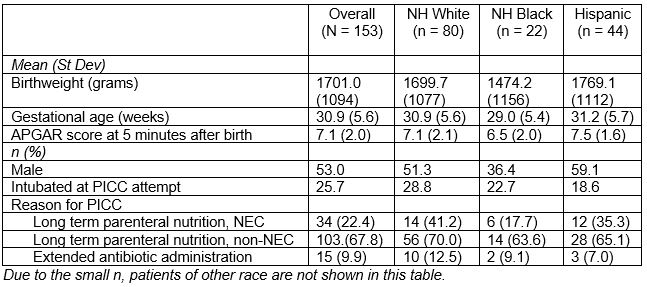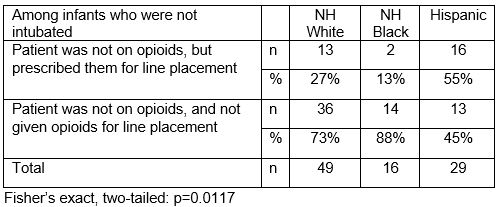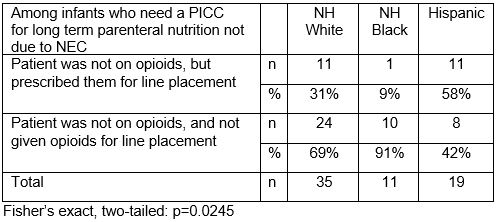Health Equity/Social Determinants of Health
Health Equity/Social Determinants of Health 8
571 - Racial and Ethnic Differences in Opioid Administration for Central Line Placement in the Neonatal Intensive Care Unit
Publication Number: 571.412

Lindsey Simoncini, MPH (she/her/hers)
Clinical Research Coordinator II
University of Massachusetts Medical School
Worcester, Massachusetts, United States
Presenting Author(s)
Background:
Racial and ethnic disparities in pharmacologic pain management have been reported in both adult and pediatric populations. However, these disparities have not been described in the neonatal intensive care unit (NICU) setting. Infants admitted to the NICU often require invasive procedures during their hospitalization, including peripherally inserted central catheter (PICC) placement. Pain management during PICC placement is not standardized, which may contribute to differential pain intervention across individuals.
Objective:
To evaluate racial/ethnic differences in opioid administration during PICC placement among infants admitted to a Level III NICU.
Design/Methods:
This was a single-center, retrospective cross-sectional study of infants admitted to the UMass Memorial Medical Center NICU from October 2017 to April 2021 for whom a PICC placement was attempted. Demographic and clinical variables were abstracted from the infant’s medical record, including parent-reported race and ethnicity, indication for PICC, and opioid administration. The primary exposure was defined as the infant’s race/ethnicity as a single variable and the primary outcome was defined as opioid administration during PICC placement. Bivariate analyses and multivariable logistic regressions were conducted.
Results:
A total of 153 infants underwent at least one PICC placement attempt during the study period; 80 (52.3%) patients were identified as non-Hispanic White, 22 (14.4%) as non-Hispanic Black/African American, 44 (28.8%) as Hispanic, and 7 (4.6%) as non-Hispanic other race. There was no significant difference between racial/ethnic groups on gender, gestational age, birthweight, prescribing provider, indication for PICC, or intubation status at time of placement (Table 1). Among non-intubated infants, Hispanic infants were more likely to be prescribed opioids for PICC placement than non-Hispanic infants (Table 2; p=0.01). Hispanic infants were also more likely to be prescribed opioids during PICC placement than non-Hispanic infants among those receiving a PICC for parenteral nutrition (PN) administration, excluding infants with necrotizing enterocolitis (NEC) (Table 3; p=0.02). There was no significant difference in opioid use between racial/ethnic groups among infants who were intubated or received a PICC for PN administration in the context of NEC.
Conclusion(s):
This study found that among infants admitted to a Level III NICU who required a PICC, Hispanic infants were more likely to receive opioid analgesia than non-Hispanic White and non-Hispanic Black infants. Additional studies are needed to confirm this association.


